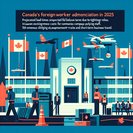
In a sharp reversal of a policy introduced only 20 months ago, Tehran has announced that ordinary Indian passport-holders will once again need a visa to enter or even transit through Iran from 22 November 2025.
The decision follows a series of disturbing cases in which Indian job-seekers were duped by unlicensed recruiters, flown into Iran under the short-lived visa-waiver scheme and then trafficked onward or held for ransom. India’s Ministry of External Affairs (MEA) says at least two dozen citizens were kidnapped this year alone, with some victims ending up in conflict zones or working illegally in the Gulf and Europe.
![Iran scraps visa-free entry for Indians after trafficking concerns]()
Under the reinstated rules airlines must verify visas at check-in, and Indian travellers who planned to use Tehran, Shiraz or Mashhad as low-cost transit hubs will now need to factor in visa fees, processing time and the risk of denial. For corporates the most immediate impact is on project cargo movements to Chabahar port and on offshore crew changes that relied on visa-free shore leave.
Travel-risk consultants are advising multinationals to route personnel through Doha or Dubai instead, while mobility managers are updating crisis-response plans for Indian assignees already in Iran. Recruiters have also been told to cease advertising “no-visa” jobs in Iran or face prosecution under India’s Emigration Act.
Longer term, observers fear the clamp-down could slow people-to-people links just as the India–Iran trade corridor gains momentum; bilateral merchandise trade topped USD 3 billion last fiscal year. MEA officials, however, stress that protecting vulnerable citizens outweighs tourism gains and say India is working with Iran on a streamlined e-visa to restore legitimate travel in 2026.
The decision follows a series of disturbing cases in which Indian job-seekers were duped by unlicensed recruiters, flown into Iran under the short-lived visa-waiver scheme and then trafficked onward or held for ransom. India’s Ministry of External Affairs (MEA) says at least two dozen citizens were kidnapped this year alone, with some victims ending up in conflict zones or working illegally in the Gulf and Europe.

Under the reinstated rules airlines must verify visas at check-in, and Indian travellers who planned to use Tehran, Shiraz or Mashhad as low-cost transit hubs will now need to factor in visa fees, processing time and the risk of denial. For corporates the most immediate impact is on project cargo movements to Chabahar port and on offshore crew changes that relied on visa-free shore leave.
Travel-risk consultants are advising multinationals to route personnel through Doha or Dubai instead, while mobility managers are updating crisis-response plans for Indian assignees already in Iran. Recruiters have also been told to cease advertising “no-visa” jobs in Iran or face prosecution under India’s Emigration Act.
Longer term, observers fear the clamp-down could slow people-to-people links just as the India–Iran trade corridor gains momentum; bilateral merchandise trade topped USD 3 billion last fiscal year. MEA officials, however, stress that protecting vulnerable citizens outweighs tourism gains and say India is working with Iran on a streamlined e-visa to restore legitimate travel in 2026.










